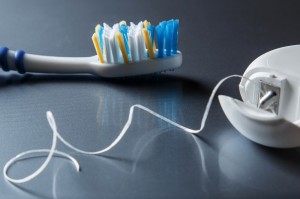 As The American Dental Association says, it’s not the type of floss that matters. What matters is that the floss gets used, used consistently, and used correctly. While string floss is still the most popular type, there are several other floss products available that you may find easier to use. Below, we’ve got the details on the different kinds of floss you’ll see in stores, along with the pros and cons of each.
As The American Dental Association says, it’s not the type of floss that matters. What matters is that the floss gets used, used consistently, and used correctly. While string floss is still the most popular type, there are several other floss products available that you may find easier to use. Below, we’ve got the details on the different kinds of floss you’ll see in stores, along with the pros and cons of each.
1. String Floss
This is by far the most common type of floss available and has been for decades. String floss is made from nylon or plastic filaments and comes waxed and unwaxed, as well as flavored or unflavored. Wax helps the floss slide between teeth, but it’s not essential and doesn’t help get your teeth any cleaner. Likewise, flavored floss helps make the experience more enjoyable for some, but it also won’t affect the cleanliness of your teeth.
The benefits of string floss are that it’s cheap, plentiful, and very widely available. One container of floss can last you a long time, and it’s easy to pack if you travel. It’s also quite easy to use once you get the proper technique down. However, it does take some dexterity to use, so young children, the elderly, or those who have problems with their hands may benefit from the sturdy support of a floss pick.
2. Floss Pick
Floss picks come in two types. The first and most common consists of a short plastic handle with a C-shaped head, with a piece of floss stretched across the opening. The handle provides better leverage and prevents you from having to create tension on the floss with your hands. This style of pick can be easier to manage for those who have trouble using their hands. Floss picks are often sold in packages of 75-100 and tend to cost between $3-5. The downside is that they do create more plastic waste than string floss, and care should be taken around young children so they don’t accidentally swallow the pick.
The other type of floss pick available is shaped like a toothpick with tiny bristles coating each end, sort of like a q-tip for your teeth. The sturdy handle is easy to use, but it may be harder to reach your back teeth due to the straight shape. They also tend to be harder to find than the C-shaped pick or regular string floss, but they’re becoming more common in drugstores these days.
3. Oral Irrigators
An oral irrigator is a tool that uses a stream of water to remove food particles from between your teeth. The oral irrigator has some kind of reservoir to hold water, either in the tool itself or in a separate container. To use it, lean over the sink and place the tool in your mouth. Slowly move the tip of the tool to the spaces between each tooth, pausing for a few seconds at each tooth to fully rid the gaps of any debris. The water and food particles will run out of your mouth and into the sink below.
Oral irrigators are the most expensive type of floss product, costing anywhere from $20-50. Although some studies have shown that this tool might not be as good at removing plaque or food particles as more traditional flossing, they have been found highly effective for reducing inflammation and improving gum health. So, this may be a worthwhile investment for people with gum disease, or for those who find it difficult to use other kinds of floss.
You may have been surprised to find that there’s a lot to talk about when it comes to dental floss. Remember, the most important kind is one that you’ll use each and every day. So, which type do you prefer? Let us know in the comments!







Leave a Reply